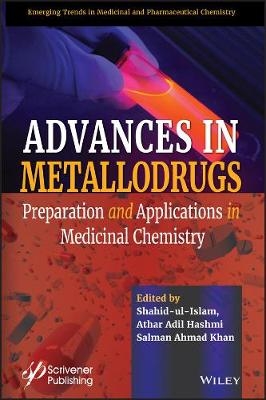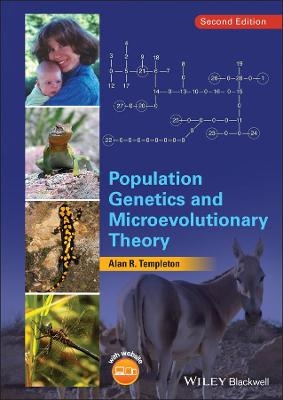
Advances in Metallodrugs
Wiley-Scrivener (Verlag)
978-1-119-64042-4 (ISBN)
Shahid-ul-Islam is a Principal Project Scientist at the Indian Institute of Technology Delhi, where he works on the chemistry of metal-based natural dyes using advanced technologies. He received his PhD in Chemistry from Jamia Millia Islamia (A Central University), New Delhi, India, in 2017. He has to his credit several research journal publications, patents and books with the Wiley-Scrivener imprint. Athar Adil Hashmi studied chemistry at Aligarh Muslim University, India and obtained his PhD in 1994. From 1990 to 2007 he held positions at the department of chemistry, Jamia Millia Islamia (Central University), New Delhi, India. Since April 2017 he is working as a visiting Professor at King Abdulaziz University, Jeddah, Kingdom of Saudi Arabia. His work area includes organometallic chemistry, metal containing polymers and bio-inorganic chemistry. Along with his international publications, book chapters, he has guided 30 postgraduate projects and 13 PhD students. Salman Ahmad Khan received his PhD in Organic Chemistry from the Jamia Millia Islamia (JMI) (A Central University), New Delhi, India, in 2007. Since 2009 he has been with the Department of Chemistry, King Abdulaziz University, Jeddah, Saudi Arabia, where he is an Associate Professor. His current research interests include Heterocyclic Chemistry, Chromones, Chalcones, Anthraquinones, Photophysical, Physicochemical, Multi steps reactions, one pot multi component synthesis and Nanotechnology. Dr. Salman is an active researcher and has published more than 100 research articles in various reputed international journals.
Preface xiii
1 Metallodrugs in Medicine: Present, Past, and Future Prospects 1
Imtiyaz Yousuf and Masrat Bashir
1.1 Introduction 2
1.2 Therapeutic Metallodrugs 6
1.2.1 Anticancer Metallodrugs 6
1.2.1.1 Mechanism of Anticancer Action 7
1.2.2 Antimicrobial and Antiviral Metallodrugs 15
1.2.2.1 Antimicrobial Metallodrugs 15
1.2.2.2 Antiviral Metallodrugs 16
1.2.3 Radiopharmaceuticals and Radiodiagnostic Metallodrugs 17
1.2.4 Anti-Diabetic Metallodrugs 19
1.2.5 Catalytic Metallodrugs 22
1.3 Future Prospects 23
1.4 Conclusion 25
References 26
2 Chemotherapeutic Potential of Ruthenium Metal Complexes Incorporating Schiff Bases 41
Manzoor Ahmad Malik, Parveez Gull, Ovas Ahmad Dar, Mohmmad Younus Wani, Md Ikbal Ahmed Talukdar and Athar Adil Hashmi
2.1 Introduction 42
2.2 Schiff Base Complexes of Ruthenium as Anticancer Agents 43
2.3 Conclusion 63
References 64
3 Role of Metallodrugs in Medicinal Inorganic Chemistry 71
Manish Kumar, Gyanendra Kumar, Arun Kant and Dhanraj T. Masram
3.1 Introduction 72
3.2 Platinum Anticancer Drugs 74
3.2.1 Nucleophilic Displacement Reactions in Complexes of Platinum 80
3.2.2 Mode of the Interaction of Cisplatin Species With Nitrogen Donors of DNA Strand 80
3.2.3 Systemic Toxicity of Cisplatin 82
3.3 Copper-Based Anticancer Complexes 82
3.3.1 Copper is Essential for Health and Nutrition 82
3.3.2 Healthcare Applications of Copper 83
3.3.3 Copper and Human Health Disorders 83
3.3.3.1 Wilson’s Disease (WD) 84
3.3.3.2 Menkes’ Disease 85
3.3.4 Role of Copper Complexes as Potential Therapeutic Agents 85
3.3.4.1 Thiosemicarbazones-Based Complexes 86
3.3.4.2 Quinolones-Based Copper Complexes 88
3.3.4.3 Naphthoquinones 88
3.4 Zinc Anticancer Complexes 89
3.4.1 Biologically Importance of Zinc 90
3.4.2 Schiff Base Chemistry 92
3.4.2.1 Schiff Base and Their Metal Complexes 92
3.4.3 Zinc-Based Complexes 93
3.4.4 Top Food Sources of Zinc 94
3.4.5 Role of Zinc in Human Body 97
3.4.6 Zinc as a Health Benefit 98
3.4.7 Zinc in Alloy and Composites 100
3.4.8 Zinc Supplementation as a Treatment 100
3.4.8.1 Zinc Deficiency 101
3.4.8.2 Zinc Toxicity 102
3.4.8.3 Zinc and Viral Infections 102
3.4.9 Gastrointestinal Effects 103
3.5 Future Prospects of Metallodrugs 103
References 104
4 Ferrocene-Based Metallodrugs 115
Hamza Shoukat, Ataf Ali Altaf and Amin Badshah
4.1 Introduction 115
4.2 Ferrocene-Based Antimalarial Agents 117
4.2.1 Mechanism of Action 118
4.3 Ferrocene-Based Antibacterial and Antifungal Drugs 118
4.3.1 Schiff Base Derived Ferrocene Conjugates as Antibacterial Agents 119
4.3.2 Ferrocenyl Guanidines as Antibacterial and Antifungal Agents 121
4.3.3 Sedaxicene as Antifungal Agents 122
4.4 Ferrocene-Based Anti-Tumor and Anti-Cancerous Drugs 123
4.4.1 Ferricenium Salts as Anti-Tumor Agents 124
4.4.2 Ferrocenylalkylazoles Active Anti-Tumor Drugs 124
4.4.3 Ferrocene Conjugated to Peptides for Lung Cancer 125
4.4.4 Ferrocenylalkyl Nucleobases Potential Anti-Cancerous Drugs 126
4.4.5 Ferrocenyl Sub-Ordinates of Illudin-M 126
4.4.6 Ferrocenyl Derivatives of Retinoids Potential Anti-Tumor Drug 127
4.4.7 Targeting Breast Cancer With Selective Ferrocene-Based Estrogen Receptor Modulators (SERM) 128
4.5 Conclusion 131
4.6 Future of Ferrocene-Based Drugs 131
References 132
5 Recent Advances in Cobalt Derived Complexes as Potential Therapeutic Agents 137
Manzoor Ahmad Malik, Ovas Ahmad Dar and Athar Adil Hashmi
5.1 Introduction 137
5.2 Cobalt Complexes as Potential Therapeutic Agents 138
5.3 Conclusion 153
References 154
6 NO-, CO-, and H2S-Based Metallopharmaceuticals 157
R. C. Maurya and J. M. Mir
6.1 Introduction 158
6.2 Signaling Molecules: Concept of “Gasotransmitter” 160
6.2.1 Therapeutic Applications of NO, CO, and H2S 162
6.2.1.1 Exogenous NO Donating Molecules 163
6.3 NO Donors Incorporated in Polymeric Matrices 167
6.3.1 Metal Nitrosyl Complexes 168
6.3.1.1 Sodium Nitroprusside (SNP) 168
6.4 Dinitrosyl Iron Thiol Complexes (DNICs) 170
6.5 Photoactive Transition Metal Nitrosyls as NO Donors 170
6.6 Exogenous CO Donating Molecules 173
6.7 H2S Donating Compounds 176
6.7.1 H2S Gas: A Fast Delivering Compound 176
6.7.2 Sulfide Salts: Fast Delivering H2S Compounds 177
6.7.3 Synthetic Moieties 178
6.7.3.1 Slow-Delivering H2S Compounds 178
6.7.3.2 H2S-Releasing Composite Compounds 179
6.7.4 Naturally Occurring Plant Derived Compounds 182
6.7.4.1 Garlic 182
6.7.4.2 Broccoli and Other Cruciferous Vegetables 184
6.8 Concluding Remarks and Future Outlook 185
References 186
7 Platinum Complexes in Medicine and in the Treatment of Cancer 203
Rakesh Kumar Ameta and Parth Malik
7.1 What is Cancer? 203
7.1.1 Characteristic Features of Cancer Cells 205
7.1.2 Definition of Anticancer Compound 206
7.1.3 Anticancer Attributes of Pt Complexes 207
7.1.4 Native State Behavior of Pt Complexes 208
7.2 Compatibility of Pt Compounds in Cancer Treatment 209
7.2.1 Significance of DNA as Primary Target 209
7.2.2 Kinetics of DNA Binding Activities 210
7.2.3 Structural and Regioselectivity of DNA Adducts 210
7.2.4 Studies on Action Mechanism 211
7.3 Pt Complexes as Anticancer Drugs 214
7.3.1 DNA-Coordinating Pt(II) Complexes 214
7.3.2 DNA-Covalently Binding Pt(II) Complexes 219
7.3.3 Targeted Pt(II) Complexes 222
7.3.4 Pt(IV) Prodrugs 224
7.3.5 Multiple Action of Pt(IV) Prodrugs 225
7.3.6 Targeted Pt(IV) Prodrugs 228
7.3.7 Photodynamic Killing of Cancer Cell by Pt Complexes 231
7.4 Conclusion 231
Acknowledgments 232
References 232
8 Recent Advances in Gold Complexes as Anticancer Agents 247
Mohammad Nadeem Lone, Zubaid-ul-khazir, Ghulam Nabi Yatoo, Javid A. Banday and Irshad A. Wani
8.1 Introduction 248
8.2 Evolution of Metal Complexes as Anticancer Agents 250
8.3 Gold Complexes 251
8.3.1 Complexes with Nitrogen Donar Ligands 252
8.3.2 Complexes with Sulphur Donar Ligands 254
8.3.3 Complexes with Phosphorus Donar Ligands 255
8.3.4 Complexes with Sulphur-Phosphorus Donar Ligands 256
8.3.5 Organometallic Gold Complexes 259
8.3.6 Miscellaneous 260
8.4 Nano-Formulations of Gold Complexes 262
8.5 Future Challenges and Perspectives 263
8.6 Conclusion 265
Acknowledgements 266
References 266
9 Recent Developments in Small Molecular HIV-1 and Hepatitis B Virus RNase H Inhibitors 273
Fenju Wei, Dongwei Kang, Luis Menéndez-Arias, Xinyong Liu and Peng Zhan
9.1 Introduction 273
9.1.1 Activity and Function of HIV and HBV RNases H 274
9.1.2 The Metal-Chelating RNase H Active Site 274
9.2 RNase H Inhibitors and Strategies in the Discovery of Active Compounds 276
9.2.1 High-Throughput Screening 276
9.2.2 Design Based on Pharmacophore Models 278
9.2.3 Novel Inhibitors Obtained by Using “Click Chemistry” 279
9.2.4 Dual-Target Inhibitors Against HIV-1 Integrase (IN) and RNase H 280
9.2.5 Inhibitors Obtained by Using Privileged Fragment-Based Libraries 282
9.2.6 RNase H Inhibitors in Natural Products 283
9.2.7 Drug Repurposing Based on Privileged Structures 284
9.3 Conclusion 286
References 287
10 The Role of Metals and Metallodrugs in the Modulation of Angiogenesis 293
Mehmet Varol and Tuğba Ören Varol
10.1 Introduction 294
10.2 Metallodrugs in Anticancer Therapy 297
10.3 Angiogenesis as a Substantial Target of Tumorigenesis 300
10.4 Metals and Metallodrugs in Angiogenesis 302
10.5 Concluding Remarks and Future Prospects 306
References 306
11 Metal-Based Cellulose: An Attractive Approach Towards Biomedicine Applications 319
Kulsoom Koser and Athar Adil Hashmi
11.1 Introduction 320
11.2 History of Cellulose 320
11.3 The Properties and Structure of Cellulose 321
11.4 Modification of Cellulose 322
11.4.1 Acid Hydrolysis 322
11.4.2 Oxidation 324
11.4.3 Esterification 326
11.4.4 Amidation 331
11.4.5 Carbamiation 333
11.4.6 Etherification 336
11.4.7 Nucleophilic Substitution 339
11.4.8 Further Modification 341
11.5 Present and Future Medical Applications of Cellulose as Well as Its Components 344
11.5.1 Cellulose Used as Wound Dressing 344
11.5.2 Dental Applications 345
11.5.3 Engineering 346
11.5.4 Controllable Drug Delivery System 348
11.5.5 Blood Purification 348
11.5.6 Wrapping Purpose 350
11.5.7 Renal Failure 351
11.6 Conclusion 351
References 352
12 Multifunctional Nanomedicine 363
Nobel Tomar, Maroof A. Hashmi and Athar Adil Hashmi
12.1 Introduction 364
12.2 Diagnostics and Imaging 366
12.3 Drug Delivery and Therapy 369
12.3.1 Drug Delivery by Organic Nanomaterials 369
12.3.1.1 Liposomal Drug Delivery 369
12.3.1.2 Polymeric Drug Delivery 371
12.3.1.3 Proteins and Peptides for Drug Delivery 373
2.3.2 Drug Delivery by Inorganic Nanomaterials 374
12.3.2.1 Metal and Metal Oxides 374
12.3.2.2 Au NPs 375
12.3.2.3 Carbon-Based NPs 375
12.3.2.4 Silicon-Based Nanostructures for Drug Delivery 378
12.3.3 Photo Therapy 379
12.3.3.1 Photodynamic Therapy 380
12.3.3.2 Photothermal Therapy 381
12.3.4 Radiation Therapy 383
12.3.5 Neutron Capture Therapy 384
12.4 Regenerative Medicine 385
12.5 Future Prospects and Conclusion 386
References 387
Index 403
| Erscheinungsdatum | 27.08.2020 |
|---|---|
| Sprache | englisch |
| Maße | 10 x 10 mm |
| Gewicht | 454 g |
| Themenwelt | Naturwissenschaften ► Biologie ► Genetik / Molekularbiologie |
| Naturwissenschaften ► Chemie | |
| Technik ► Umwelttechnik / Biotechnologie | |
| ISBN-10 | 1-119-64042-3 / 1119640423 |
| ISBN-13 | 978-1-119-64042-4 / 9781119640424 |
| Zustand | Neuware |
| Haben Sie eine Frage zum Produkt? |
aus dem Bereich


